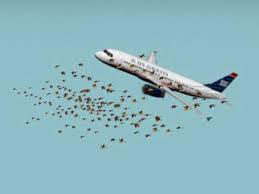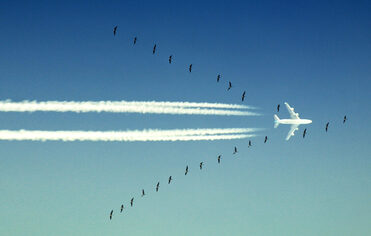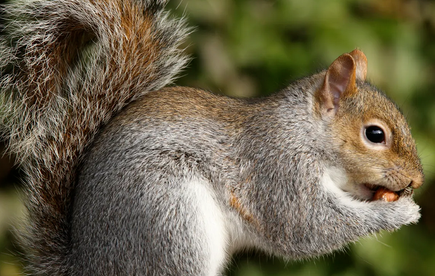 Every year airline companies in the U.S. as well airports and aviation companies are paying billions of dollars due to wildlife strikes! Building a plane isn’t cheap and repairing a plane after it collides with an animal like a deer or goose isn’t like fixing a car headlight. There have been several recent high profile newsworthy events of wildlife strikes. Former Vice President Mike Pence and Airforce 2 making an emergency landing due to a bird strike, and the most famous or memorable was the US Airways Flight 1549 landing on the Hudson River after colliding with Geese. This was notorious and important for several reasons. One it made Captain Sully Sullenberger a legend and very wealthy, two Tom Hanks won an Oscar for his performance in Sully but third and most important for the Wildlife Management industry and for every airport in the world, it showed that a bird strike can happen anywhere anytime. Now some bird strikes are going to happen no matter what, however many of collisions can be prevented by having an up to date and well executed Wildlife Hazard Management Plan and outsourcing to professionals like Loomacres Wildlife Management. (Learn More Click Here) The FAA has always addressed the importance of wildlife collisions being prevented by airports. Certain policies, procedures and regulations are mandatory for airports to comply with to ensure safety for airlines, and passengers. Below are a few mandatory items that must be implemented or complied with for airports that are classified under the FAA Title 14 Part 139.337 (e) & (f).
These are just a few examples of what the FAA has instituted for all airports that fall under the classification of Title 14 Part 139. These policies and regulations are in place to keep airport managers accountable and proactive in preventing wildlife strikes with aircrafts because at the end of the day it’s the Airport Manager who is liable and responsible for safe take off and landings. Information is key to preventing future risks and collisions. All wildlife strikes should be reported and logged in the FAA Strike Database. For more information or to schedule a WHA, WHMP Review, or Wildlife Hazard Management Training please fill out the field below.
0 Comments
 Every year the FAA requires commercial airport staff and personnel to fulfill the training requirements for an airport wildlife biologist conducting wildlife hazard assessments under Title 14, Code of Federal Regulations, Part 139 and FAA Advisory Circular 150/5200-36A. In non-technical terms the FAA mandates that required airport staff complete an 8-hour training class on wildlife hazard management and wildlife identification. After completing this course annually your airport staff will receive the necessary certificates of completion. When selecting a company to train your staff here are 5 -things to look for when choosing your P-139 Wildlife Training vendor. 1) Wildlife Hazard Management Plan Review: Having a qualified airport wildlife biologist evaluate and update your WHMP benefits both the airport manager and the airport staff. Your vendor should be requesting a copy of your WHMP to review and find any changes or updates that need to be made or suggestions on action items that need more attention. 2) Customized Training Curriculum: Often our new clients outsource their training to us at Loomacres Wildlife Management because their current vendor has been teaching the same topics the same way for years. Choosing a vendor that customizes their curriculum and training seminar based on your airports WHMP, strike history for the past 10 years, and new hazards and wildlife attractants that may be outside the airport fences is crucial. Let’s be honest, your staff will like this too and benefit greatly. 3) Virtual Training Options: With Covid-19 changing everything, the FAA granted certain companies to perform Part 139 Airport Wildlife Trainings virtually to ensure the safety of everyone. Over the past 18 months virtually training has been an adjustment but extremely efficient. This also comes in handy when a new hire starts and needs to attend a training to become certified and trained for wildlife hazard management duties on your airport. It is also a luxury to complete your training from the comfort of your office, home, or airport conference room. 4) Firearm & Pyrotechnic Safety Training: Having an NRA Certified instructor provide your staff with onsite (Local Gun Range) firearm training is important on a few levels. Having peace of mind that your staff is trained on how to properly handle a firearm, accuracy training, and safety should be on the top of your list. This also goes for training your staff on how to properly use pyrotechnics in the field by having your instructor do live onsite demonstrations. 5) Advanced Airport Management & BASH Training: These multi day courses that are in person with airport staff and airport managers from all over the country will focus on advanced wildlife management techniques for airports. This class is broken up into classroom seminars, Q&A with industry experts, and extensive hands-on training for the following topics. Trapping Techniques
At Loomacres Wildlife Management our Airport Certified Wildlife Biologist that provide our clients with virtual or in person training classes pride themselves on the above-mentioned items you should be looking for when selecting a vendor. We believe our training and training staff is the most up to date and advanced training in the industry. Don’t believe us? Click Here to see what our clients have said. If you would like to speak with a biologist or to learn more about our training program, please fill out the contact fields below or click on the link to our website.  Ok homeowners, with the world seemingly divided on just about every major issue there is one thing we can all agree upon and that is our hatred for squirrels, and they are annoying! There I said it. With winter upon us for most of the country the time where squirrels seek shelter from the elements and to begin their nesting phase like a pregnant woman nearing her delivery date. Now I am sure we all remember the iconic squirrel in the Christmas tree scene of Christmas Vacation that plays on repeat during this holiday season and yes that is a possibility but here are four tips to help prevent any unwanted winter guests in your attic and home. 1. Check Exterior: No better time then checking the exterior of your home when its cold outside and you’re hanging holiday lights. If you fear heights, we don’t recommend this, but it should be done. Check for holes in your roof, siding, or access in your chimney vents where squirrels, birds, and other critters could possibly enter your home. If a point of entry is found simple DIY exclusion work should help or contact an expert (Click here for expert) 2. Remove Food: If you have bird feeders or feeding stations for wildlife in your back yard this is for you. Watching birds feed in the winter or waking up to deer, rabbits and other wildlife on a winter morning is an absolute welcome sight and yes everyone and everything needs to eat! However careful what you wish for. If you store your seed or feed in your garage or shed, chances are something is coming for it. Try keeping it in a storage container outside and sealed with a brick or cinder block on it to help weigh it down. Click here for Image 3. Trapping: This may not be for everyone, but it is highly effective and can be fun. There are various types of traps from lethal to non-lethal that can rid your property of squirrels. We highly recommend Comstock Custom Traps. As a specious overall they really aren’t that hard to trap especially for beginners. However, we advise you to contact your state regulations on either daily amounts or removal and replacement regulations. Click here for Traps 4. Hunting: Which ever side of the aisle you are on when it comes to hunting it doesn’t matter because hunters serve a significant purpose when it comes to population control and effectiveness. Typically, animals like squirrels invade homes because they have run out of natural resources in their own habitat and have no other choice. By thinning out a dense population of squirrels in an area you are preventing a future issue. We recommend reviewing your state and local regulations to make sure no laws are broken but this is a quick way to solve any issue. For more information or to contact an expert at Loomacres Wildlife Management for a free consultation please click here and someone will help you as soon as possible.
|
Sales & Marketing
|
 RSS Feed
RSS Feed